

Index of CSS properties. W3C cheatsheet. The encoding used for an HTML page that contains a form should support all the characters needed to enter data into that form.
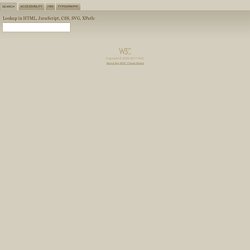
This is particularly important if users are likely to enter information in multiple languages. Databases and scripts that receive data from forms on pages in multiple languages must also be able to support the characters for all those languages simultaneously. The simplest way to enable this is to use Unicode for both pages containing forms and all back-end processing and storage. In such a scenario the user can fill in data in whatever language and script they need to.
You should also try to avoid making assumptions that things such as the user's name and address will follow the same formatting rules as your own. If you are gathering information from people in more than one country, it is important to develop a strategy for addressing the different formats people will expect to be able to use. So, how do I do this?
Présentation de ce cours complet JavaScript. Vos dons permettent la création de nouveaux cours Objectifs de ce tutoriel JavaScript et prérequis Bienvenue dans ce nouveau cours traitant du langage de programmation JavaScript.
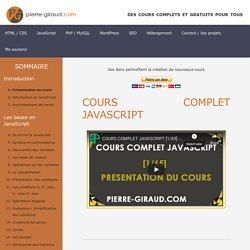
Ce tutoriel est accessible à tous et pourra être bénéfique à chacun, que vous soyez déjà un expert en JavaScript ou un complet néophyte. Le seul prérequis indispensable pour suivre ce cours est d’avoir déjà de bonnes notions en HTML et en CSS, car dans le cas contraire vous ne pourrez pas suivre ce tutoriel. Si vous ne connaissez pas du tout le HTML ou le CSS, je vous invite à d’abord aller suivre mon tutoriel complet traitant de ces deux langages ici. Les objectifs de ce cours sont avant tout de vous présenter le fonctionnement du JavaScript et vous présenter les possibilités offertes par ce langage.
W3Schools Online Web Tutorials. Web technology for developers. Documentation du Web - MDN. Extensible Markup Language (XML) 1.0 (Fifth Edition) 2 Documents [Definition: A data object is an XML document if it is well-formed, as defined in this specification.
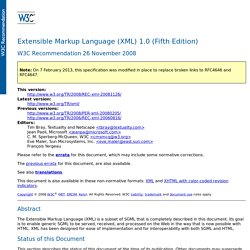
In addition, the XML document is valid if it meets certain further constraints.] Each XML document has both a logical and a physical structure. Physically, the document is composed of units called entities. An entity may refer to other entities to cause their inclusion in the document. 2.1 Well-Formed XML Documents [Definition: A textual object is a well-formed XML document if:] Taken as a whole, it matches the production labeled document.It meets all the well-formedness constraints given in this specification.Each of the parsed entities which is referenced directly or indirectly within the document is well-formed.
Document Matching the document production implies that: It contains one or more elements. 2.2 Characters [Definition: A parsed entity contains text, a sequence of characters, which may represent markup or character data.] Character Range Note: White Space Names and Tokens <! WhatWG HTML Standard. XHTML 1.0 Strict Cheat Sheet. See also: XHTML Basic 1.1 cheat sheet — Recommended Doctype Declarations — XHTML Flavors comparisons.
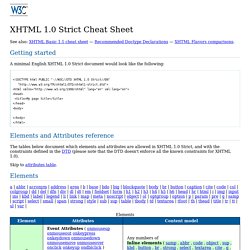
Getting started. HTML 4.01 Specification. Abstract This specification defines the HyperText Markup Language (HTML), the publishing language of the World Wide Web.
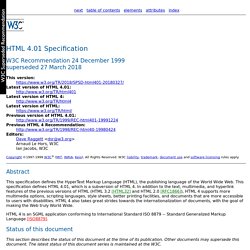
This specification defines HTML 4.01, which is a subversion of HTML 4. In addition to the text, multimedia, and hyperlink features of the previous versions of HTML (HTML 3.2 [HTML32] and HTML 2.0 [RFC1866]), HTML 4 supports more multimedia options, scripting languages, style sheets, better printing facilities, and documents that are more accessible to users with disabilities.
HTML 4 also takes great strides towards the internationalization of documents, with the goal of making the Web truly World Wide. HTML 4 is an SGML application conforming to International Standard ISO 8879 -- Standard Generalized Markup Language [ISO8879]. Status of this document This section describes the status of this document at the time of its publication. This document has been reviewed by W3C Members and other interested parties and has been endorsed by the Director as a W3C Recommendation. XHTML 1.0: The Extensible HyperText Markup Language (Second Edition) A Reformulation of HTML 4 in XML 1.0 W3C Recommendation 26 January 2000, revised 1 August 2002 superseded 27 March 2018.
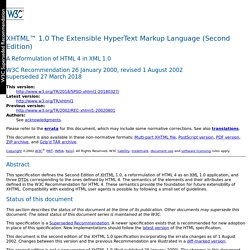
The W3C Markup Validation Service. World Wide Web Consortium (W3C)